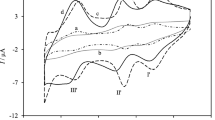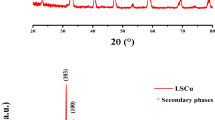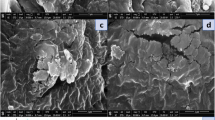Abstract
A novel ionic liquid/α-ZrP (C16MIM/α-ZrP) lamellar nanocomposite was fabricated via the electrostatic self-assembly deposition technique by using exfoliated α-ZrP nanosheets and guest molecules (1-hexadecyl-3-methylimidazolium bromide) as building blocks under mild conditions. C16MIM/α-ZrP nanocomposite was characterized by various analytical techniques such as X-ray diffraction (XRD), transmission electron microscopy (TEM), scanning electron microscope (SEM), Fourier transform infrared spectroscopy, and synchronous thermal analyzer. The net interlayer spacing of α-ZrP determined by XRD confirmed that the C16MIM cations formed a monolayer arrangement between the α-ZrP nanosheets. The morphology and microstructure of C16MIM/α-ZrP composite were observed using SEM and TEM. The C16MIM/α-ZrP modified glass carbon electrode exhibited excellent electrocatalytic activity toward the oxidation of nitrite in weak base media. The results obtained with differential pulse voltammetry demonstrated that the C16MIM/α-ZrP hybrid detected nitrite linearly in the concentration range from 7.3 μM to 1.25 mM with the detection limit of 1.26 μM (S/N = 3). Additionally, the prepared sensor showed outstanding reproducibility, high stability, and anti-interference capability.










Similar content being viewed by others
References
C. Jo, H.J. Ahn, J.H. Son, J.W. Lee, and M.W. Byun: Packaging and irradiation effect on lipid oxidation, color, residual nitrite content, and nitrosamine formation in cooked pork sausage. Food Contr. 14, 7 (2003).
R. Cao, H. Huang, J. Liang, T. Wang, Y. Luo, A.M. Asiri, H. Ye, and X. Sun: A MoN nanosheet array supported on carbon cloth as an efficient electrochemical sensor for nitrite detection. Analyst 144, 5378 (2019).
M.J. Moorcroft, J. Davis, and R.G. Compton: Detection and determination of nitrate and nitrite: A review. Talanta 54, 785 (2001).
S.S. Mirvish: Role of N-nitroso compounds (NOC) and N-nitrosation in etiology of gastric, esophageal, nasopharyngeal and bladder cancer and contribution to cancer of known exposures to NOC. Cancer Lett. 93, 17 (1995).
R. Wang, Z. Wang, X. Xiang, R. Zhang, X. Shi, and X. Sun: MnO2 nanoarrays: An efficient catalyst electrode for nitrite electroreduction toward sensing and NH3 synthesis applications. Chem. Commun. 54, 10340 (2018).
N. Pourreza, M.R. Fat'hi, and A. Hatami: Indirect cloud point extraction and spectrophotometric determination of nitrite in water and meat products. Microchem. J. 104, 22 (2012).
A. Idrissi, C. Ruckebusch, B. Debus, L. Boussekey, and P. Damay: Probing local structure of sub and supercritical CO2 by using two-dimensional Raman correlation spectroscopy. J. Mol. Liq. 164, 11 (2011).
Z. Lin, W. Xue, H. Chen, and J.M. Lin: Peroxynitrous-acid-induced chemiluminescence of fluorescent carbon dots for nitrite sensing. Anal. Chem. 83, 8245 (2011).
W.S. Jobgen, S.C. Jobgen, H. Li, C.J. Meininger, and G. Wu: Analysis of nitrite and nitrate in biological samples using high-performance liquid chromatography. J. Chromatogr. B 851, 71 (2007).
V.K. Gupta, A.K. Singh, and L.K. Kumawat: Thiazole Schiff base turn-on fluorescent chemosensor for Al3+ ion. Sens. Actuat., B 195, 98 (2014).
K.M. Miranda, M.G. Espey, and D.A. Wink: A rapid, simple spectrophotometric method for simultaneous detection of nitrate and nitrite. Nitric Oxide 5, 62 (2001).
U.P. Azad, S. Turllapati, P.K. Rastogi, and V. Ganesan: Tris(1,10-phenanthroline)iron(II)-bentonite film as efficient electrochemical sensing platform for nitrite determination. Electrochim. Acta 127, 193 (2014).
B. Yuan, C. Xu, L. Liu, Y. Shi, S. Li, R. Zhang, and D. Zhang: Polyethylenimine-bridged graphene oxide–gold film on glassy carbon electrode and its electrocatalytic activity toward nitrite and hydrogen peroxide. Sens. Actuat., B 198, 55 (2014).
A. Afkhami, F. Soltani-Felehgari, T. Madrakian, and H. Ghaedi: Surface decoration of multi-walled carbon nanotubes modified carbon paste electrode with gold nanoparticles for electro-oxidation and sensitive determination of nitrite. Biosens. Bioelectron 51, 379 (2014).
C. Tan, X. Cao, X. Wu, Q. He, J. Yang, X. Zhang, J. Chen, W. Zhao, S. Han, and G. Nam: Recent advances in ultrathin two-dimensional nanomaterials. Chem. Rev. 117, 6225 (2017).
S. Lu, M. Hummel, S. Kang, and Z. Gu: Selective voltammetric determination of nitrite using cobalt phthalocyanine modified on multiwalled carbon nanotubes. J. Electrochem. Soc. 167, 046515 (2020).
S. Lu, M. Hummel, K. Chen, Y. Zhou, S. Kang, and Z. Gu: Synthesis of Au@ZIF-8 nanocomposites for enhanced electrochemical detection of dopamine. Electrochem. Commun. 114, 106715 (2020).
V.K. Gupta, H. Karimi-Maleh, and R. Sadegh: Simultaneous determination of hydroxylamine, phenol and sulfite in water and waste water samples using a voltammetric nanosensor. Int. J. Electrochem. Sci. 10, 303 (2015).
T.L. Greaves and C.J. Drummond: Protic ionic liquids: Properties and applications. Chem. Rev. 108, 206 (2008).
Q. Zhang, S. Zhang, and Y. Deng: Recent advances in ionic liquid catalysis. Green Chem. 13, 2619 (2011).
M. Smiglak, A. Metlen, and R.D. Rogers: The second evolution of ionic liquids: From solvents and separations to advanced materials—energetic examples from the ionic liquid cookbook. Acc. Chem. Res. 40, 1182 (2007).
V.J. Cadarso, J. Perera-Nuñez, A. Mendez-Vilas, L. Labajos-Broncano, M.-L. González-Martín, and J. Brugger: Microdrop generation and deposition of ionic liquids. J. Mater. Res. 29, 2100 (2014).
K. Põhako-Esko, M. Timusk, K. Saal, R. Lõhmus, I. Kink, and U. Mäeorg: Increased conductivity of polymerized ionic liquids through the use of a nonpolymerizable ionic liquid additive. J. Mater. Res. 28, 3086 (2013).
M. Galiński, A. Lewandowski, and I. Stępniak: Ionic liquids as electrolytes. Electrochim. Acta 51, 5567 (2006).
H. Xu, H.-Y. Xiong, Q.-X. Zeng, L. Jia, Y. Wang, and S.-F. Wang: Direct electrochemistry and electrocatalysis of heme proteins immobilized in single-wall carbon nanotubes-surfactant films in room temperature ionic liquids. Electrochem. Commun. 11, 286 (2009).
D. Wei and A. Ivaska: Applications of ionic liquids in electrochemical sensors. Anal. Chim. Acta 607, 126 (2008).
Z. Zhang, D. Wang, M. Yang, L. Liu, J. Ma, M. Wang, C. Zhang, D. Zhang, and Z. Tong: Electrostatic self-assembly deposition of layered calcium niobate intercalated with task-specific ionic liquid and its electrocatalytic activity. Chem. Lett. 46, 506 (2017).
A. Clearfield: Inorganic ion exchangers with layered structures. Annu. Rev. Mater. Sci. 14, 205 (1984).
G. Alberti: Syntheses, crystalline structure, and ion-exchange properties of insoluble acid salts of tetravalent metals and their salt forms. Acc. Chem. Res. 11, 163 (1978).
L. Sun, W.J. Boo, R.L. Browning, H.-J. Sue, and A. Clearfield: Effect of crystallinity on the intercalation of monoamine in α-zirconium phosphate layer structure. Chem. Mater. 17, 5606 (2005).
L. Sun, W.J. Boo, H.-J. Sue, and A. Clearfield: Preparation of α-zirconium phosphate nanoplatelets with wide variations in aspect ratios. New J. Chem. 31, 39 (2007).
L. Sun, J.Y. O'Reilly, D. Kong, J.Y. Su, W.J. Boo, H.J. Sue, and A. Clearfield: The effect of guest molecular architecture and host crystallinity upon the mechanism of the intercalation reaction. J. Colloid Interface Sci. 333, 503 (2009).
S. Lu, M. Hummel, Z. Gu, Y. Gu, Z. Cen, L. Wei, Y. Zhou, C. Zhang, and C. Yang: Trash to treasure: A novel chemical route to synthesis of NiO/C for hydrogen production. Int. J. Hydrogen Energ. 44, 16144 (2019).
T. Xu, D. Ma, C. Li, Q. Liu, S. Lu, A.M. Asiri, C. Yang, and X. Sun: Ambient electrochemical NH3 synthesis from N2 and water enabled by ZrO2 nanoparticles. Chem. Commun. 56, 3673 (2020).
B. Wan, R.G. Anthony, G.Z. Peng, and A. Clearfield: Characterization of organically pillared zirconium phosphates. J. Catal. 101, 19 (1986).
Y. Liu, C. Lu, W. Hou, and J.J. Zhu: Direct electron transfer of hemoglobin in layered alpha-zirconium phosphate with a high thermal stability. Anal. Biochem. 375, 27 (2008).
B. Pan, J. Ma, X. Zhang, J. Li, L. Liu, D. Zhang, M. Yang, and Z. Tong: A laminar nanocomposite constructed by self-assembly of exfoliated α-ZrP nanosheets and manganese porphyrin for use in the electrocatalytic oxidation of nitrite. J. Mater. Sci. 50, 6469 (2015).
C.V. Kumar, and A. Chaudhari: Proteins immobilized at the galleries of layered α-zirconium phosphate: Structure and activity studies. J. Am. Chem. Soc. 122, 830 (2000).
A. Chaudhari, J. Thota, and C.V. Kumar: Binding and cleavage studies of two proteins intercalated at the galleries of α-zirconium phosphate. Micropor. Mesopor. Mat. 75, 281 (2004).
A. Bhambhani and C.V. Kumar: Enzyme-inorganic nanoporous materials: Stabilization of proteins intercalated in α-zirconium(IV) phosphate by a denaturant. Micropor. Mesopor. Mat. 110, 517 (2008).
C. Ruan, F. Yang, J. Xu, C. Lei, and J. Deng: Immobilization of methylene blue using α-zirconium phosphate and its application within a reagentless amperometric hydrogen peroxide biosensor. Electroanalysis 9, 1180 (1997).
J. Ma, M. Yang, Y. Chen, L. Liu, X. Zhang, M. Wang, D. Zhang, and Z. Tong: Sandwich-structured composite from the direct coassembly of layered titanate nanosheets and Mn porphyrin and its electrocatalytic performance for nitrite oxidation. Mater. Lett. 150, 122 (2015).
J. Ma, Z. Zhang, M. Yang, Y. Wu, X. Feng, L. Liu, X. Zhang, and Z. Tong: Intercalated methylene blue between calcium niobate nanosheets by ESD technique for electrocatalytic oxidation of ascorbic acid. Micropor. Mesopor. Mat. 221, 123 (2016).
F. Geng, R. Ma, Y. Yamauchi, and T. Sasaki: Tetrabutylphosphonium ions as a new swelling/delamination agent for layered compounds. Chem. Commun. 50, 9977 (2014).
K. Dal pont, J.F. Gérard, and E. Espuche: Modification of α-ZrP nanofillers by amines of different chain length: Consequences on the morphology and mechanical properties of styrene butadiene rubber based nanocomposites. Eur. Polym. J. 48, 217 (2012).
B. Pan, J. Ma, X. Zhang, L. Liu, D. Zhang, J. Li, M. Yang, Z. Zhang, and Z. Tong: Sandwich-structured nanocomposite constructed by fabrication of exfoliation α-ZrP nanosheets and cobalt porphyrin utilized for electrocatalytic oxygen reduction. Micropor. Mesopor. Mat. 223, 213 (2016).
A. Tarafdar, A.B. Panda, N.C. Pradhan, and P. Pramanik: Synthesis of spherical mesostructured zirconium phosphate with acidic properties. Micropor. Mesopor. Mat. 95, 360 (2006).
J.-M. Jian, L. Fu, J. Ji, L. Lin, X. Guo, and T.-L. Ren: Electrochemically reduced graphene oxide/gold nanoparticles composite modified screen-printed carbon electrode for effective electrocatalytic analysis of nitrite in foods. Sens. Actuat., B 262, 125 (2018).
E. Laviron: General expression of the linear potential sweep voltammogram in the case of diffusionless electrochemical systems. J. Electroanal. Chem. 101, 19 (1979).
E. Laviron: Adsorption, autoinhibition and autocatalysis in polarography and in linear potential sweep voltammetry. J. Electroanal. Chem. 52, 355 (1974).
L. Fu, S. Yu, L. Thompson, and A. Yu: Development of a novel nitrite electrochemical sensor by stepwise in situ formation of palladium and reduced graphene oxide nanocomposites. RSC Adv. 5, 40111 (2015).
N. Nombona, P. Tau, N. Sehlotho, and T. Nyokong: Electrochemical and electrocatalytic properties of α-substituted manganese and titanium phthalocyanines. Electrochim. Acta 53, 3139 (2008).
M. Ghanei-Motlagh and M.A. Taher: A novel electrochemical sensor based on silver/halloysite nanotube/molybdenum disulfide nanocomposite for efficient nitrite sensing. Biosens. Bioelectron. 109, 279 (2018).
Y. Li, Y. Bai, G. Han, and M. Li: Porous-reduced graphene oxide for fabricating an amperometric acetylcholinesterase biosensor. Sens. Actuat., B 185, 706 (2013).
T. Lopes, L. Andrade, H.A. Ribeiro, and A. Mendes: Characterization of photoelectrochemical cells for water splitting by electrochemical impedance spectroscopy. Int. J. Hydrogen Energ. 35, 11601 (2010).
N. Maleki, A. Safavi, and F. Tajabadi: Investigation of the role of ionic liquids in imparting electrocatalytic behavior to carbon paste electrode. Electroanalysis 19, 2247 (2007).
Z. Fan, L. Sun, S. Wu, C. Liu, M. Wang, J. Xu, X. Zhang, and Z. Tong: Preparation of manganese porphyrin/niobium tungstate nanocomposites for enhanced electrochemical detection of nitrite. J. Mater. Sci. 54, 10204 (2019).
M. Wang, Z. Fan, L. Yi, J. Xu, X. Zhang, and Z. Tong: Construction of iron porphyrin/titanoniobate nanosheet sensors for the sensitive detection of nitrite. J. Mater. Sci. 53, 11403 (2018).
F. Hu, S. Chen, C. Wang, R. Yuan, D. Yuan, and C. Wang: Study on the application of reduced graphene oxide and multiwall carbon nanotubes hybrid materials for simultaneous determination of catechol, hydroquinone, p-cresol and nitrite. Anal. Chim. Acta 724, 40 (2012).
M. Wang, C. Liu, X. Zhang, Z. Fan, J. Xu, and Z. Tong: In situ synthesis of CsTi2NbO7@g-C3N4 core–shell heterojunction with excellent electrocatalytic performance for the detection of nitrite. J. Mater. Res. 33, 3936 (2018).
Acknowledgments
This work was supported by Priority Academic Program Development of Jiangsu Higher Education Institutions (PAPD), the First-class Undergraduate Majors Construction Program of Jiangsu Province, and the Key Discipline Construction Program of Jiangsu Province. We are also grateful to Jiangsu Industry-University-Research Cooperation Project, Lianyungang Haiyan Project (2019-QD-013), Lianyungang Huaguoshan Talent Program, and Innovation Project of College Student and Graduate Student of Jiangsu Province (KYCX19-2267, KYCX20-2948, and KYCX20-2949).
Author information
Authors and Affiliations
Corresponding author
Supplementary material
Supplementary material
To view supplementary material for this article, please visit https://doi.org/10.1557/jmr.2020.225.
Rights and permissions
About this article
Cite this article
Ge, Y., Gu, F., Liu, L. et al. Nitrite sensor based on room temperature ionic liquid functionalized α-zirconium phosphate modified glassy carbon electrode. Journal of Materials Research 35, 3058–3066 (2020). https://doi.org/10.1557/jmr.2020.225
Received:
Accepted:
Published:
Issue Date:
DOI: https://doi.org/10.1557/jmr.2020.225




